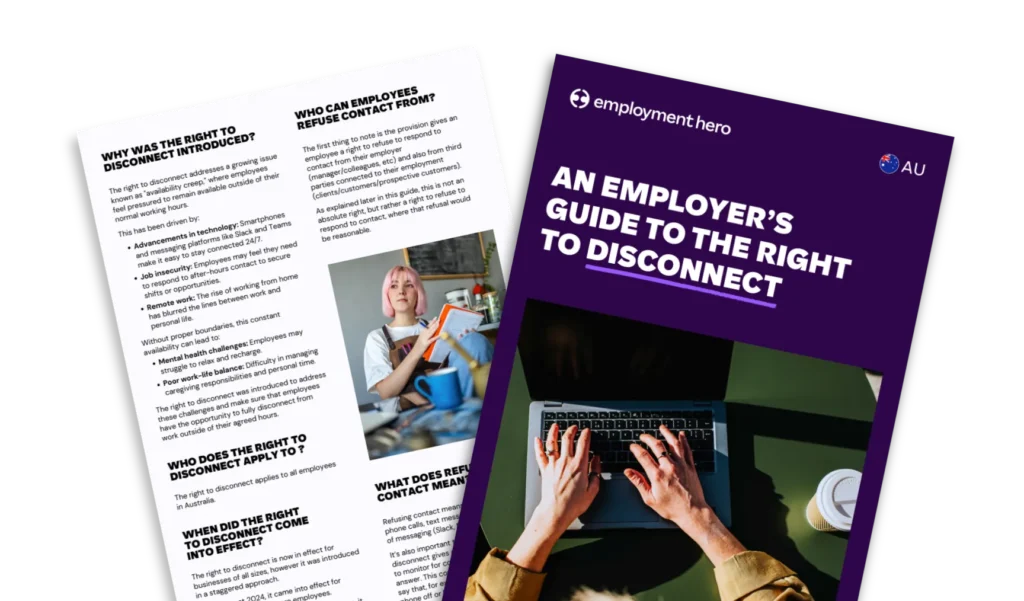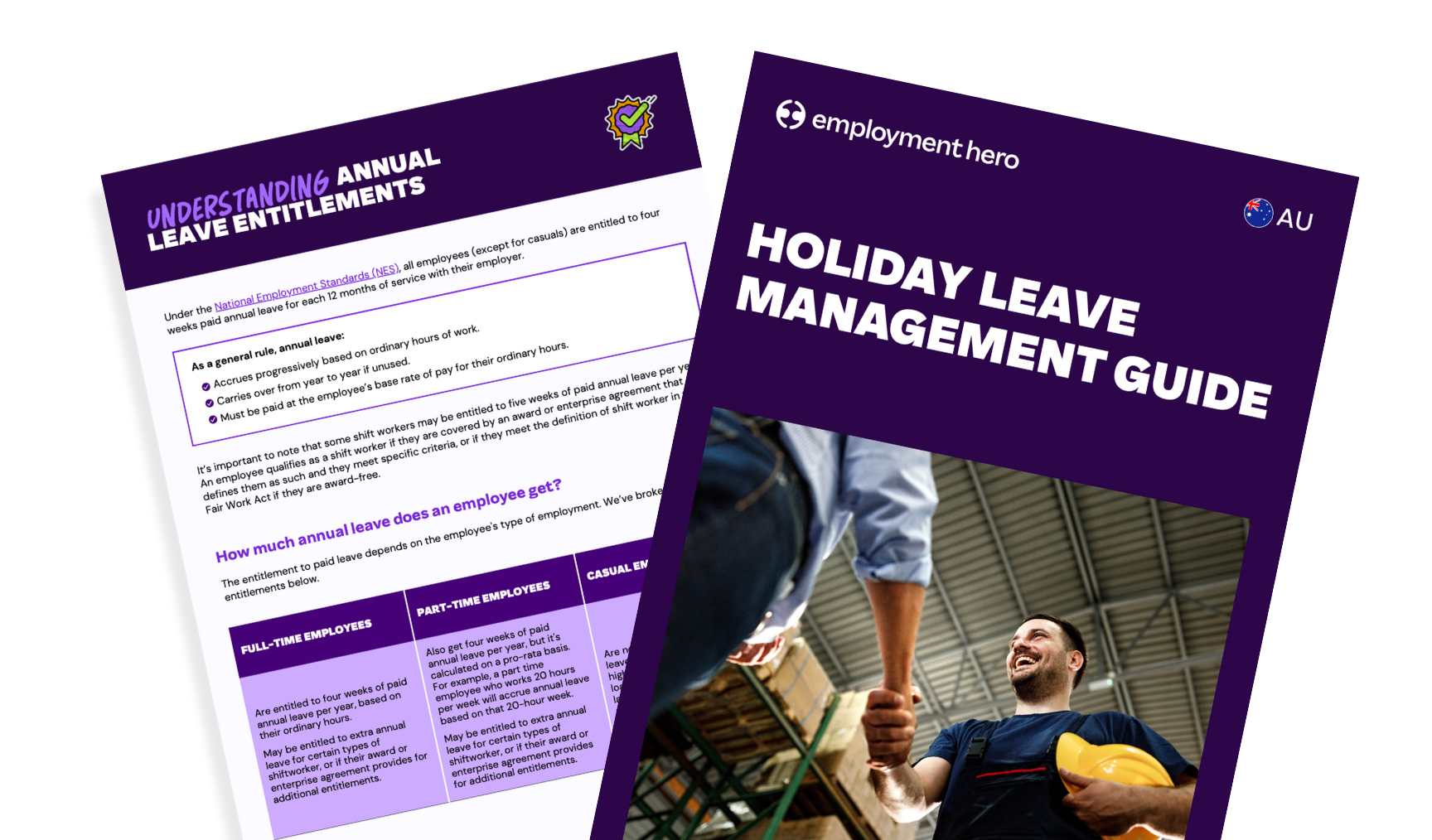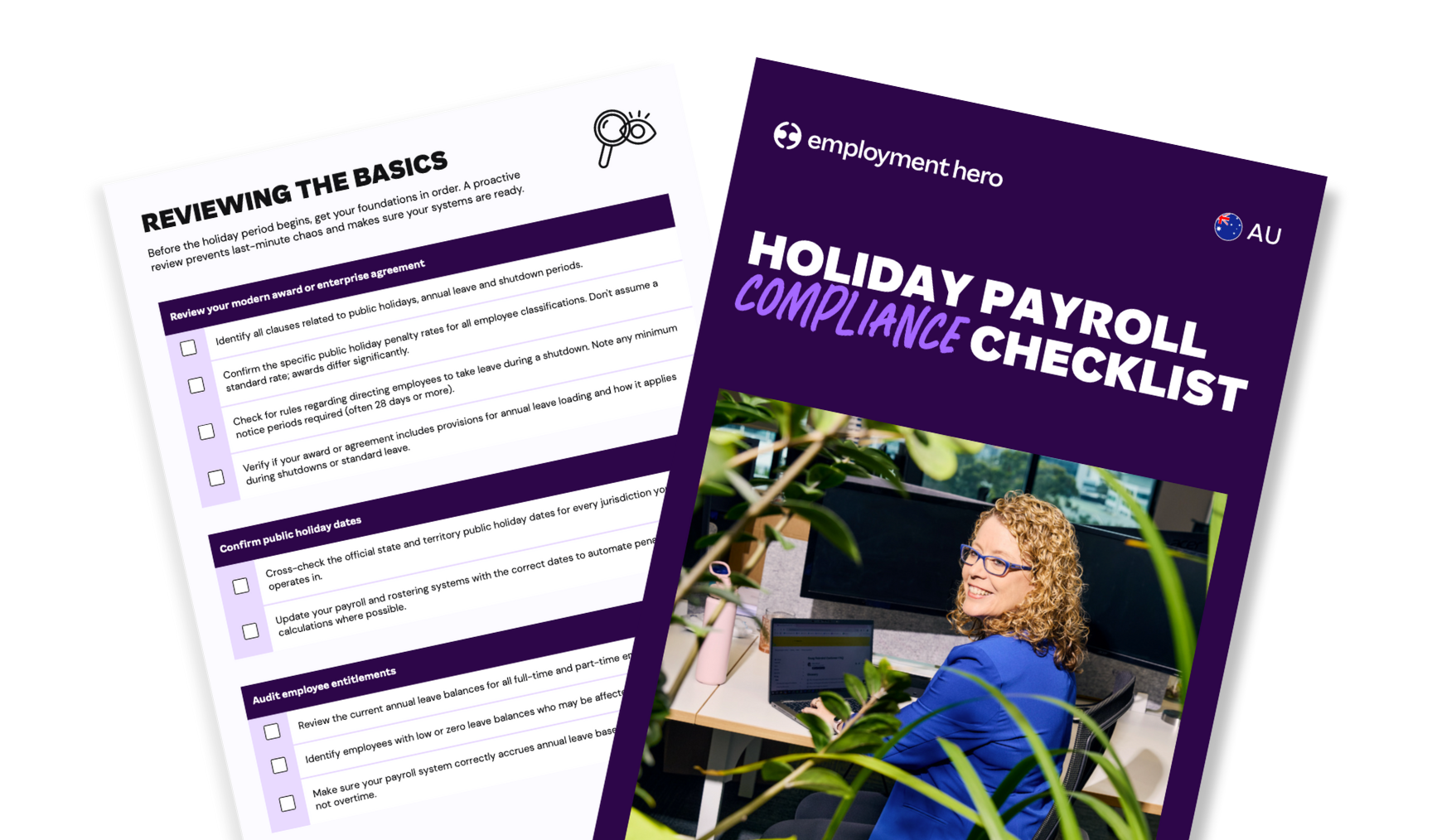
For years, “always on” has been the unspoken expectation of the Australian workplace. After-hours calls, emails and the quiet pressure to stay connected long after the workday ends.
But in August 2024, Australia officially drew a line in the sand. The ‘Right to Disconnect’, introduced under the Closing Loopholes Bill, now gives employees the legal right to switch off after work.
What does this guide cover?
In the right to disconnect guide, you’ll find information on:
- What is the right to disconnect and why was it introduced?
- Who can employees refuse contact from?
- Will employers commit an offence if they send a message to an employee outside of working hours?
- What is considered reasonable and unreasonable contact?
- Practical tips for compliance
Download the guide now by filling in the form on the right hand side.

What is the right to disconnect?
The right to disconnect is a new workplace entitlement introduced into Australian employment law. It allows employees to refuse to monitor, read or respond to work-related communications outside of their working hours, unless the contact is deemed reasonable. This includes contact from employers, colleagues, clients, or customers.
The legislation is designed to protect employees’ mental health, work-life balance and personal responsibilities by setting clear boundaries between work and personal time.
Who does the right to disconnect apply to?
The right to disconnect applies to all employees in Australia.
When did the right to disconnect take effect?
The right to disconnect is now in effect for businesses of all sizes, however it was introduced in a staggered approach.
For employers with 15 or more employees
On 26 August 2024, the legislation came into effect for businesses with 15 or more employees. This includes full-time, part-time and casual employees. Businesses of this size were expected to have policies and procedures in place by this date to manage their compliance obligations.
For small business employers
For businesses with fewer than 15 employees, the right to disconnect came into effect on 26 August 2025. This delayed start date acknowledged the challenges and limited resources of smaller businesses, giving them an additional year to adapt to the new requirements.

When is it unreasonable for an employee to refuse contact?
Helpfully, the new legislation sets out a non-exhaustive list of five matters that must be taken into account when considering reasonableness for contact after hours.
- The reason for the contact or attempted contact
- How the contact or attempted contact is made and the level of disruption the contact or attempted contact causes the employee
- The extent to which the employee is compensated:
- (i) to remain available to perform work during the period in which the contact or attempted contact is made; or
- (ii) for working additional hours outside of the employee’s ordinary hours of work
- The nature of the employee’s role and the employee’s level of responsibility
- The employee’s personal circumstances (including family or caring responsibilities)
In our full guide, we include in-depth commentary and examples from our Head of HR Advisory, Simon Obee.
Right to disconnect terms in modern awards
The Fair Work Commission has now added a right to disconnect clause to all modern awards. These clauses outline when employers can contact employees outside their regular working hours without breaching the new rules. This can include:
A stand-by or on-call allowance
If an employee’s award includes a stand-by or on-call allowance, they’re being paid to be available after hours. In this case, an employer can contact them if:
- The employee is receiving the allowance;
- The contact is to let them know they’re required to work; and
- The contact follows the usual on-call process.
Emergency roster changes
If an award allows emergency roster changes with 48 hours’ notice or less, an employer can contact the employee after hours to inform them of the change — as long as it follows the normal notification process.
Recall to work
Where an award includes a recall to work provision (often with extra pay), an employer can contact an employee after hours to notify them they’re being recalled. Again, following the usual process.

Resolving right to disconnect disputes
The new legislation outlines how disputes about the right to disconnect must be handled. Employers and employees should first try to resolve any issues internally through open discussion.
If that fails, either party can apply to the Fair Work Commission (FWC) for help. The FWC can issue orders to:
- Stop an employer from requiring after-hours contact;
- Stop an employee from unreasonably ignoring contact; or
- Prevent disciplinary action against an employee for reasonably refusing contact.
While the Commission can’t impose financial penalties directly, breaching one of its orders can lead to fines. The right to disconnect is also a workplace right under the Fair Work Act, meaning serious penalties apply if an employer takes adverse action against an employee for exercising their right to disconnect.
Download our full guide for a detailed walkthrough of the dispute process and how to manage your compliance obligations.

Employment Hero can boost your compliance confidence
Want to automate your HR, payroll and compliance? Employment Hero’s Employment Operating System can help your business navigate these changes with ease. Get in touch with one of our business specialists to learn how.
Want personalised support relating to the right to disconnect? Our HR Advisory service can help you make sure your obligations are covered.
And lastly, if you’re looking for more helpful guides on managing compliance, check out our Essential HR Compliance Guide and HR Audit Checklist now.
Download the Right to Disconnect Guide
Download the Right to Disconnect Guide to learn exactly what the new rules mean for your business and how to implement them with confidence.
Disclaimer: The information in this guide is relevant as at 28 October 2025, and has been prepared by Employment Hero Pty Ltd ABN (11 160 047 709) (Employment Hero). The views expressed herein are general information only and are provided in good faith to assist employers and their employees. The Information is based on data supplied by third parties. While such data is believed to be accurate, it has not been independently verified and no warranties are given that it is complete, accurate, up to date or fit for the purpose for which it is required. Employment Hero does not accept responsibility for any inaccuracy in such data and is not liable for any loss or damages arising either directly or indirectly as a result of reliance on, use of or inability to use any information provided in this guide.
Register for the factsheet
Related Resources
-
 Read more: Holiday leave guide for Australian employers
Read more: Holiday leave guide for Australian employersHoliday leave guide for Australian employers
Learn how to manage annual leave and Christmas leave requests in Australia. Understand entitlements, calculations and employer rights with our…
-
 Read more: Public holiday pay guide for Australian employers in 2026
Read more: Public holiday pay guide for Australian employers in 2026Public holiday pay guide for Australian employers in 2026
Understand public holiday pay in Australia. Learn how to calculate rates, entitlements and award conditions with our free guide.
-
 Read more: Holiday payroll checklist for employers
Read more: Holiday payroll checklist for employersHoliday payroll checklist for employers
Use our holiday payroll checklist to manage shutdowns, public holiday pay, overtime, bonuses and compliance. Stay on top of payroll…






















